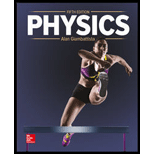
Concept explainers
(a)
The spring constant.
(a)
Answer to Problem 65P
Spring constant of the spring is
Explanation of Solution
Write the expression for the force acting on the spring.
Here,
Write the expression for the weight hanging on the spring.
Here,
Since weight is hanging from the string. Force acting on the spring is equal to weight of the mass.
Therefore, write the expression for force acting on the spring.
Rearrange above equation to get
Conclusion:
Substitute
Therefore, spring constant of the spring is
(b)
The elastic potential energy stored in the spring.
(b)
Answer to Problem 65P
The elastic potential energy stored in the spring is
Explanation of Solution
The elastic potential energy stored in the spring.
Here,
Substitute
Conclusion:
Substitute
Therefore, the elastic potential energy stored in the spring is
(c)
The second mass if it can produce an elongation of
(c)
Answer to Problem 65P
The second mass if it can produce an elongation of
Explanation of Solution
Let
Write the expression for the spring constant in terms of new mass and elongation.
Spring constant of the spring is a constant independent of force.
Conclusion:
Divide equation (II) by (I) to get
Substitute
Therefore, the second mass if it can produce an elongation of
Want to see more full solutions like this?
Chapter 6 Solutions
Physics
 College PhysicsPhysicsISBN:9781305952300Author:Raymond A. Serway, Chris VuillePublisher:Cengage Learning
College PhysicsPhysicsISBN:9781305952300Author:Raymond A. Serway, Chris VuillePublisher:Cengage Learning University Physics (14th Edition)PhysicsISBN:9780133969290Author:Hugh D. Young, Roger A. FreedmanPublisher:PEARSON
University Physics (14th Edition)PhysicsISBN:9780133969290Author:Hugh D. Young, Roger A. FreedmanPublisher:PEARSON Introduction To Quantum MechanicsPhysicsISBN:9781107189638Author:Griffiths, David J., Schroeter, Darrell F.Publisher:Cambridge University Press
Introduction To Quantum MechanicsPhysicsISBN:9781107189638Author:Griffiths, David J., Schroeter, Darrell F.Publisher:Cambridge University Press Physics for Scientists and EngineersPhysicsISBN:9781337553278Author:Raymond A. Serway, John W. JewettPublisher:Cengage Learning
Physics for Scientists and EngineersPhysicsISBN:9781337553278Author:Raymond A. Serway, John W. JewettPublisher:Cengage Learning Lecture- Tutorials for Introductory AstronomyPhysicsISBN:9780321820464Author:Edward E. Prather, Tim P. Slater, Jeff P. Adams, Gina BrissendenPublisher:Addison-Wesley
Lecture- Tutorials for Introductory AstronomyPhysicsISBN:9780321820464Author:Edward E. Prather, Tim P. Slater, Jeff P. Adams, Gina BrissendenPublisher:Addison-Wesley College Physics: A Strategic Approach (4th Editio...PhysicsISBN:9780134609034Author:Randall D. Knight (Professor Emeritus), Brian Jones, Stuart FieldPublisher:PEARSON
College Physics: A Strategic Approach (4th Editio...PhysicsISBN:9780134609034Author:Randall D. Knight (Professor Emeritus), Brian Jones, Stuart FieldPublisher:PEARSON





